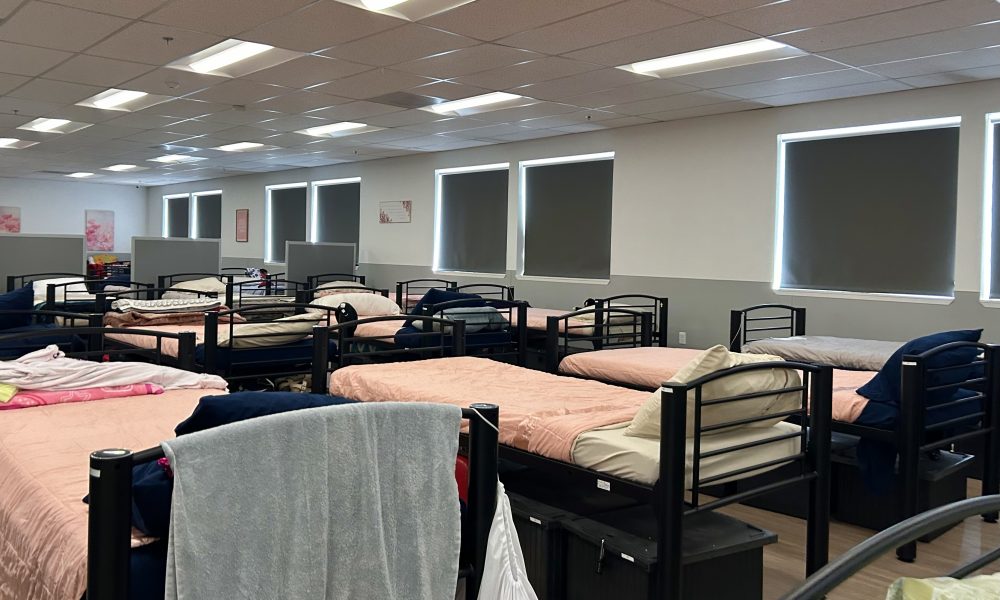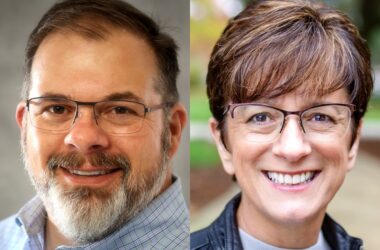Forty-two people, previously unsheltered, are now resting their heads in a spacious sleeping hall decorated with colorful paintings and lined with dozens of twin beds and twelve bunk beds.
Salem’s new Navigation Center is a city-funded shelter intended to help chronically homeless people through intensive case management that connects them to public benefits, health services and permanent housing. It accepted its first guests in early June after a years-long effort to secure funding and renovate a building. The center is run under a contract with The ARCHES Project.
Center staff are now gearing up to eventually serve 75 people, accepting around five new guests every week for a “healthy ramp-up” said Sara Webb, ARCHES program director for sheltering services.
Dubbed the “crown jewel” of the city’s homeless response by Mayor Chris Hoy, the center has been in the works for years, with funding first approved in 2021.
The navigation center offers short-term stays and is intended to help people find stable housing while offering a safe bed, a warm shower, and access to health care and housing resources. As a low-barrier shelter, they accept people with pets and partners. Sobriety isn’t required to stay.
State and city leaders have thus far invested $15.5 million to get the center up and running, opening it in June despite not having city money to run it beyond 2025. It is estimated to cost $2.4 million to keep open each year.
“There is pressure to fill the beds quickly because of all the money that has gone into this facility,” said Webb.
Placements into the navigation center all come through referrals from Marion and Polk county homeless service partners who are looking for people who could do well in a congregate shelter environment.
Salem police, Northwest Human Services, the Marion County Sheriff’s Office, the psychiatric crisis center and ARCHES Project’s outreach teams helped identify people to fill the first beds.
Ashley Hamilton, the chief program officer for ARCHES parent agency, Mid-Willamette Valley Community Action, said that they started by with women first as they tend to be “more vulnerable and victimized.”
Potential residents are screened to make sure they can perform daily tasks independently, like using the bathroom, feeding themselves and bathing. Staff also look at any health issues and trauma that might inhibit their ability to live at the center.
The screening is all to “make sure they are going to be successful here,” said Webb.
An incoming guest gets a bed placement while their belongings go in the “bed bug sauna” at the front entrance for an hour.
Women sleep on one half of the space and men sleep on the other half with gray dividers separating the section. Everyone is given four black bins for storage under their beds. There is also have a private room off the main sleeping area that can fit six beds for people who do not do well in the large sleeping hall.
The staff at the center help get newcomers acquainted with the space. People can take a shower or do laundry in the hallway behind the sleeping area or get some rest. Within 24 hours of their entrance, shelter workers hope people will start meeting with their case manager to set goals and build rapport, said Webb.
They let clients determine their own goals, which could be finding housing, working on mental health or addiction, getting Social Security, or anything else they determine. Then it’s up to the case managers to help them. The program hopes that everyone will want to work towards some goal.
“We have 100% engagement even though it’s not mandatory,” said Webb.
People can get mental health and addiction treatment onsite provided by JD Health and Wellness, which has an office with a separate entrance to the building. Clients can receive lifetime health services at the center.
The center’s aim is to keep people for less than 90 days and move them into housing with year-long leases as quickly as possible. That’s made possible through state funds for rapid rehousing, which allows ARCHES to cover initial housing costs for a year, Hamilton said.
A day in the navigation center starts around 6 a.m. when people begin stirring. Lights to the sleeping area go on at 8 a.m. and breakfast is served from 8 to 9:30 a.m. Then the sleeping area closes at 10 a.m.
Only people working night jobs or with special medical needs are allowed in the sleeping area during the day.
People usually leave the center during the day but are allowed to stay and hang out in the living area where the lights are dimmed to watch a movie on the couch, do a puzzle at the table, read a book or eat.
People often have weekly appointments with the in-house services, but scheduling can look different for every person, said Webb.
The center serves lunch from 12 to 1:30 p.m. and then dinner from 5 to 6:30 p.m. All three daily meals are hot meals prepared in their commercial kitchen, and most of the food they use is from donations.
The sleeping porch opens back up at 8 p.m. and lights are out at 10 p.m. Webb said that people have a difficult time adjusting to is the 10 p.m. curfew.
Although they are not a sober facility, people are not allowed to hold drugs or alcohol on site, which has been difficult for people who drink or use medical marijuana for pain, Webb said.
They perform random bed checks regularly and if guests are found with contraband they can throw it away in the amnesty box that is picked up by Salem police. Staff try to not kick people out and instead have a conversation about how the substances fit their larger goals.
So far they have had both positive and negative departures, said Webb. Some people left for permanent housing and others left because of behavioral issues or opted to leave because it wasn’t right for them.
“Open bay sleeping is not for everybody,” said Webb. “I think there’s a chunk of people that came in right off the bat that weren’t quite prepared for the structure that came with it.”
Hamilton said they are wary of the congregate shelter model but have worked with the city and vendors to pick furniture, paint colors, and textiles to design the space and give it “a homey feeling you could be comfortable and feel safe.”
With so many people sleeping in one big area, there have been a few fights, but nothing extreme or physical, said Webb.
“You get a lot of personalities under one roof, so yeah, that’s bound to happen,” said Webb.
The majority of people served at the navigation center are chronically homeless, meaning they have been living outside for a year or longer. Hamilton said many of the people they serve are actively experiencing trauma and need a lot of help to get stable.
Between mental health, physical health and addiction, many guests will need lifelong assistance, said Webb. The center’s goal is to get them off the streets and into a safe environment.
One client died in her sleep about a month ago, said Webb. Staff found her not breathing in the morning after everyone had gotten up. Medics who responded attributed the death to heart issues, she said.
“The thing about being homeless is that it’s incredibly hard on your body,” said Webb, “By the time people get indoors, I think their nervous system often takes a break. And so it’s not completely uncommon to have chronic homeless people die once they’re housed, because your body for the first time can sort of relax.”
Salem has few low-barrier shelters which allow pets, don’t require sobriety and allow couples.
Webb said that these shelter beds are “really meant to be life-saving.”
Once someone is placed in a longer-term program housing or care program they do a “warm handoff” and stay engaged with the client while they transition.
Both Webb and Hamilton said they are very happy with how operations at the center have been going in these early months.
“It’s just been a learning curve and figuring out what works for this environment and what doesn’t. All in all, I think it’s been pretty successful,” said Webb.
City officials intended to fund the Navigation Center’s ongoing operations through revenue from a payroll tax, which councilors narrowly passed in a 5-4 vote in July. The tax was expected to bring in about $28 million a year, including $7.9 million for the center and city-funded micro shelter sites.
But that funding remains uncertain: the tax is set to go before voters in November following a successful referendum campaign.
Webb said that in the world of social work, “the truth is none of our funding is guaranteed past the next two years, it never is. And we’re always going year to year hoping that things get re-funded.”
Hamilton said that they entered into the agreement knowing there could be a potential shortfall in funding and they are confident there are so many other investment opportunities and options that can keep the Navigation Center going.
“I don’t think the success of Navigation Center lands on how council or the citizens in Salem vote,” said Hamilton.
The navigation center is continuing to add around five new residents a week and leaders hope it will be at full capacity in the coming months.
They want people who lower needs who will be able to thrive in a congregate living situation.
PRIOR COVERAGE
Yet to open, Salem’s homeless navigation center could be out of money by 2025
Long-awaited homeless navigation center opens in Salem with fanfare
Salem won’t be getting state help for key homeless services out of 2023 session
City expects homeless navigation center to open February
State, county funds for navigation center to go before city council Monday
Contact reporter Natalie Sharp: [email protected] or 503-522-6493.
SUPPORT OUR WORK – We depend on subscribers for resources to report on Salem with care and depth, fairness and accuracy. Subscribe today to get our daily newsletters and more. Click I want to subscribe!

Natalie Sharp is an Oregon State University student working as a reporter for Salem Reporter in summer 2023. She is part of the Snowden internship program at the University of Oregon's School of Communication and Journalism.









